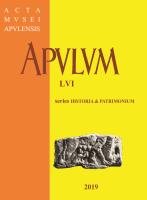Unirea de la 1918 în presa greco-catolică bihoreană (1928-1940)
The Union from 1918 in the Greek-Catholic Press from Bihor County (1928-1940)
The Union from 1918 in the Greek-Catholic Press from Bihor County (1928-1940)
Author(s): Silviu SanaSubject(s): History, Interwar Period (1920 - 1939)
Published by: Muzeul National al Unirii Alba Iulia
Keywords: Union from 1918; Alba Iulia; Greek-Catholic Diocese from Oradea; Vestitorul; national unity; Christian values; history;
Summary/Abstract: This paper entitled "The Union from 1918 in the Greek-Catholic press from Bihor County (1928-1940)" wants to be a "recollection" of those who lived through the events from 1918-1919, at the 10th and 20th anniversary. The commemorative and memorialist items are analysed, their purpose being that of drawing attention to the role of the Greek Catholic Church in the Union of 1918 and to restore the events that have succeeded in this short period.The Greek-Catholic periodical press from the canonical territory of Diocese of Oradea was successfully represented for over two decades of the interwar period through the periodical Vestitorul / Herald. Being also the official periodical magazine of the Diocese, with the role of transmitting official information to priests and believers, the editors from that time did not miss the 10th and 20th anniversary of the unification of Transylvania with Romania. Thus, in 1928-1929 and 1938, a series of articles appeared having as subject the Union from 1918. These were written by the priest and believers who experienced those moments of enthusiasm, tension or even fear, the articles examining, in many places, the emotion of the person, especially in the memoirs’ accounts. The great majority of those who wrote about the Union of 1918 and the events of February-April 1919 were priests, their discourse being peppered with theological and church issues. The themes of theological and ecclesiastical issues reflect not only the status of the authors but also the Christian conception on history and human life. Thus, the main theme is related to the intervention of the Providence in the history of the Romanian people which, in 1918, culminated with the achievement of national unity. The Union from 1 December 1918 is the reward of God for the centuries of suffering of the Romanians from Transylvania. The historical themes deal with both generalities on the history of the Romanian people and details about the events between 1918 and 1919. We find here the contribution to the history of the High school from Beius during the Bolshevik occupation, the “movie” of the Great National Assembly from Alba Iulia reported by a theologian student, the account of the episode of the arrest and beatings suffered by the archpriest Augustin Târziu from Chereluş (Arad County). The theme of patriotism, namely the love of the nation and the country, is present in almost all articles, with moralizing implication: homeland love means honest work, unity and fear of God; the duty towards the country must be done by examining one’s conscience; the cemeteries where the Romanian heroes are buried are as many schools of homeland and nation love; the love of homeland and nation calls for the defence of the country in face of external aggressions; the commemoration of the Union from December 1, 1918 is set as an indicator in the personal review of Christian life, to be prepared to serve the country and the nation. At the same time, the articles have a special apologetic tone, the anniversary of the Union from 1918 being the occasion to remind both the history and especially the rights of the Greek-Catholic Church in the new state, Romania. The authors do this precisely as a reaction to the fact that the Greek-Catholic Church has been removed from the political-social background of the new state, the politicians of the Old Kingdom seeking to diminish its rights and the Romanian Orthodox Church to annihilate it by repeatedly attacking it, especially in the press. Among the present apologetic themes, we have: respecting the rights of the Greek-Catholic Church, expressing gratitude to this Church whose sons suffered for the entire Romanian nation, the role of this Church in the Union from December 1, 1918, and the sacrifice brought by its priests and believers, the role of this Church in formation of characters that served the Romanian nation.In conclusion, based on the analysis of those written by the authors of the diocese, we can say that the Union of 1918 was commemorated in the years 1928, 1929 and 1938. They sought not to set aside any person or event – from the distant past or recent – a sign that both the history and the memories of eyewitnesses intertwined, building the historical journey of the Romanian national unity. Commemoration or anniversary, the Union from 1918 was an opportunity for authors to convey a clear message to the readers. On the one hand, by highlighting the past it reminded the origins and the works of the Romanians, and on the other, this reminder balanced the values of the past with the realities of the present, and the opportunity to inspire all Romanians to contribute further to the prosperity of Romania and especially the spiritual unification of all Romanians. Although there were no nominal references to politicians and brothers from the Romanian Orthodox Church who obstructed the Greek-Catholic Church after the 1918 Union, these articles reported to the public the role of this church in building the national identity and unity, while calling on all Romanians to assume Christian values, guarding the highest of them, Brotherly love, the greatest strength of a nation.
Journal: Apulum
- Issue Year: 56/2019
- Issue No: 1
- Page Range: 199-221
- Page Count: 23
- Language: Romanian
- Content File-PDF

